Working Principle of an Ordinary Microscope:
In an ordinary microscope, the object is viewed due to differences in colour intensities of the specimen. To create the colour intensities, the specimen is first stained with suitable dyes which will impart specific colour. In an ordinary microscope, the contrast is obtained when the light rays pass through a stained specimen because different stains absorb different amounts of light. These differential absorption properties of stained specimen modify the intensity or amplitude of the light waves transmitted by different regions of the cells and this ultimately creates contrast in the image. Thus, staining is essential to create contrast in an ordinary microscope. Moreover, the unstained specimen cannot be observed through an ordinary microscope.
Download the PPT (Phase Contrast Microscopy)
Why Phase Contrast Microscope?
The Phase Contrast Microscope is used to visualize unstained living cells. Most of the stains or staining procedures will kill the cells. Phase contrast microscopy enables the visualization of living cells and life events.
You may also like NOTES in...
BOTANY BIOCHEMISTRY MOL. BIOLOGY
ZOOLOGY MICROBIOLOGY BIOSTATISTICS
ECOLOGY IMMUNOLOGY BIOTECHNOLOGY
GENETICS EMBRYOLOGY PHYSIOLOGY
EVOLUTION BIOPHYSICS BIOINFORMATICS
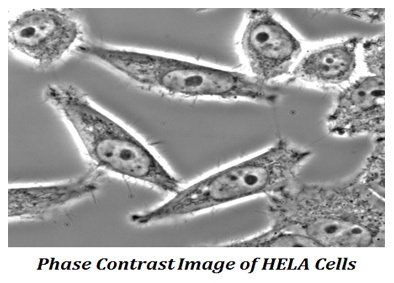

History of Phase Contrast Microscope
The Phase Contrast Microscope was developed by Zernike in early 1930s. The invention of this microscope enables us to visualize live cells and cellular processes. Due to the remarkable contribution of phase contrast microscopy in biological sciences, the inventor was awarded Nobel Prize in Physics in 1953.
Learn more: Phase Contrast vs DIC Microscopy
Working Principle of Phase Contrast Microscopy
The phase contrast microscopy is based on the principle that small phase changes in the light rays, induced by differences in the thickness and refractive index of the different parts of an object, can be transformed into differences in brightness or light intensity.
In simple terms, phase contrast microscopy is the translation of invisible phase shifts into visible differences of intensities. The phase changes are not detectable to human eye whereas the brightness or light intensity can be easily detected by the human eyes.
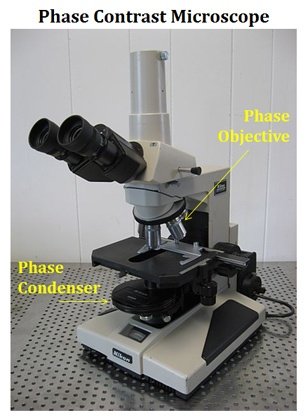
Optical Components of Phase Contrast Microscope
The phase contrast microscope is similar to an ordinary compound microscope in its optical composition. Similar to a normal microscope, it possesses a light source, condenser system, objective lens system and ocular lens system.
A phase contrast microscope differs from the normal microscope in having TWO additional components:
(1). Sub-stage Annular Diaphragm
(2). Phase Plate
(1). Sub-stage Annular Diaphragm
It is located below the sub-stage condenser of the microscope. The sub-stage annular diaphragm helps to create a narrow, hollow cone or ring of light to illuminate the object.
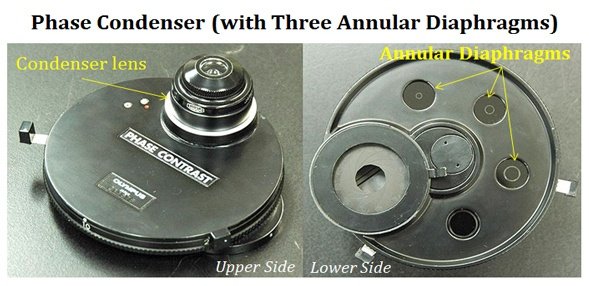
(2). Phase Plate
The phase plate is also called as diffraction plate or phase retardation plate. It is located at the back focal plane of the objective lens. The phase retarding components are coated on this plate. The phase plate is a transparent glass disc with one or few channels. The channel is coated with a material that can absorb light but cannot retard it. The other portion (other than channel) of the phase plate is coated with light retarding materials such as Magnesium fluoride. Phase plate helps to reduce the phase of the incident light.

How Contrast is Created in Phase Contrast Microscopy?
The unstained cells cannot create contrast under the normal microscope. However, when the lights pass through an unstained cell, it encounters regions in the cells with different refractive indexes and thickness. When light rays pass through an area of high refractive index, it deviates from its normal path and such a light ray experiences phase change or phase retardation. Light rays pass through the area of less refractive index remain undeviated (no phase change).
The difference in the phases between the retarded and un-retarded light rays is about ¼ of original wave length (i.e., λ/4). Human eyes are NOT able to detect this minute changes in the phase of light and thus, such small phase changes do not create any contrast in the image. The phase contrast microscope has special devices (annular diaphragm and phase plate), which convert these minute phase changes into amplitude changes or brightness changes so that a contrast difference can be created in the final image. This contrast difference can be easily detected by our eyes.
Let’s see how phase contrast microscope achieves contrast in the image without staining of the object. In phase contrast microscope, in order to get contrast, the diffracted waves have to be separated from the direct waves. This separation is achieved by the sub-stage annular diaphragm.
The annular diaphragm illuminates the specimen with a hollow cone of light. Some rays (direct rays) pass through the thinner region of the specimen and do not undergo any retardation and they directly enter into the objective lens. The light rays passing through the denser region of the specimen get regarded and they run with a delayed phase than the undeviated rays. The retardation of the phase of light is about ¼ of the λ of the incident light. Both the retarded and unretarded light has to pass through the phase plate kept on the back focal plane of the objective to form the final image.
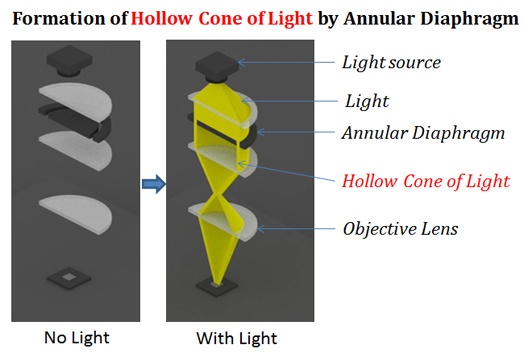
The phase plate is designed and positioned in such a way that the retarded light rays will pass through the area of phase plate where light retarding materials are coated. When the ¼ (or λ/4) retarded light is passed through this region of phase plate, it is further retarded by ¼ (or λ/4). With this, the final change or retardation will be- ¼λ + ¼λ = ½λ (or λ/4 + λ/4 = λ/2). The un-retarded rays will pass through the channels of the phase plate and their phase is not altered by the phase plate.
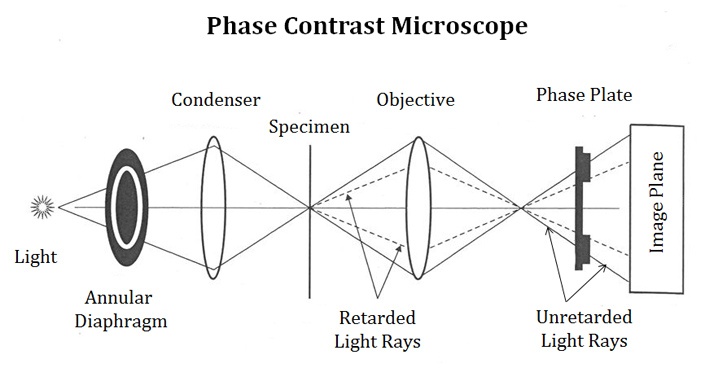
When the unretarded and ½λ (or λ/2) retarded light are recombined (at the focal point), a negative or destructive interference is created because the crest and trough of the unretarded and retarded light rays will cancel each other. With the destructive interference, the image of the specimen appears darker against a bright background. On the other hand, if the un-deviated light rays are passed through the phase regarding material, the two rays will be in the same phase and the result will be a positive or constructive interference. In constructive interference, the image of the specimen becomes brighter against a dark background. Thus in phase contrast microscopy, the combination of destructive and constructive interferences creates high contrast in the final image.
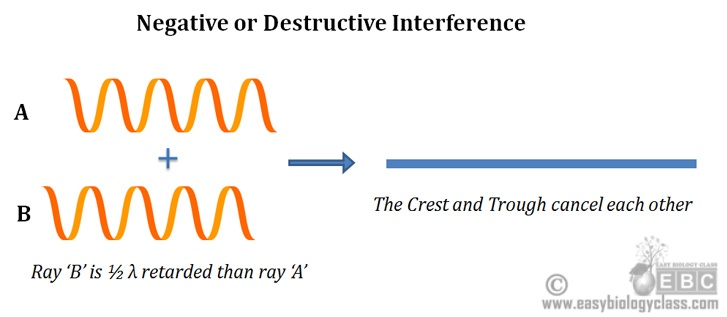
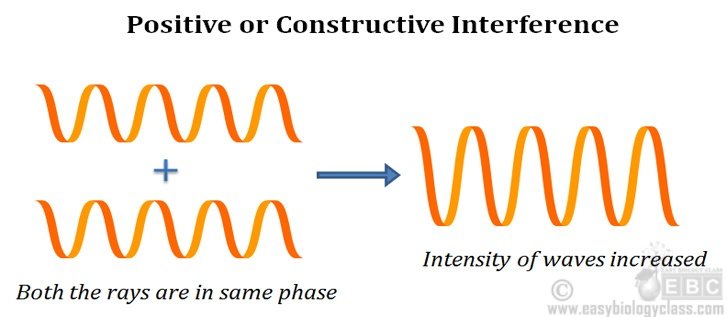
Applications of Phase Contrast Microscopy
The magnification and resolution phase contrast microscope is similar to that of an ordinary microscope. Still, PCM has many applications in biological sciences. The applications of phase contrast microscopy can be summarized as:
Ø PCM enables the visualization of living cells.
Ø It enables visualization of unstained cells.
Ø PCM can be used to view various cell organelles (mitochondria, nucleus, and vacuoles).
Ø Helps to study the cellular events such as cell division, phagocytosis, cyclosis etc.
Ø Used to visualize all types of cellular movements such as chromosomal and flagellar movements.
Ø Enable the study of cytoskeleton dynamics during cell division, phagocytosis etc.
Ø Enable the study of membrane permeability of cells and different organelles.
Ø Phase contrast microscopy is extensively used to observe living cells in tissue culture to monitor their growth
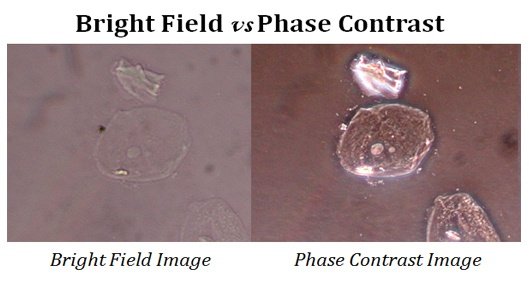
Advantages of Phase Contrast Microscope
Ø Provide the clear image of unstained cells.
Ø Avoid damages of the cells due to chemical preparation and staining.
Ø Provide high contrast images highlighting the fine details of the cells.
Ø The optical construction is relatively simple.
Ø A compound microscope can be elevated to phase contrast microscope with minor additions.
Ø Enable prolonged observation of living cells without losing the viability of cells.
Ø Live cell imaging and live process monitoring are possible.
Ø Affordable cost.
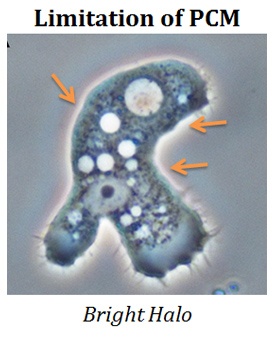
Disadvantages / Limitations of Phase Contrast Microscope
Ø Phase contrast microscope produces a bright halo around the images. The formation of the halo is due to the partial or incomplete separation of direct and deviated rays.
Ø PCM is only useful for viewing individual cells or thin layer of cells.
You might also like…
@. Difference between Phase Contrast Microscope and DIC
@. Difference between Light and Electron Microscope
Download PPT of Phase Contrast Microscopy
More Lecture Notes from Easy Biology Class…
BotanyZoologyBiochemistryGeneticsCell & Molecular BiologyBiotechnologyPhysiology & EndocrinologyPlant PhysiologyMicrobiologyImmunologyEmbryologyEcologyEvolutionBiophysicsResearch MethodologyBiostatisticsChemistry for BiologistsPhysics for Biologists
Browse more in Easy Biology Class…
Lecture NotesBiology PPTsVideo TutorialsBiology MCQQuestion BankDifference betweenPractical AidsMock Tests (Online)Biology Exams

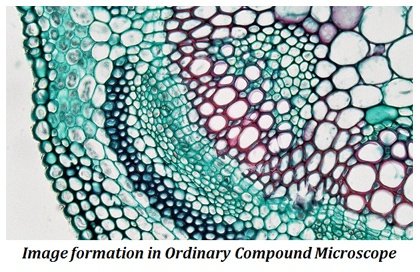
The differential study is very easy to understand…..Thank you
These notes are excellent. They are so easy to understand. Thanks for posting.
Thanks for phase contrast microscope just superb.